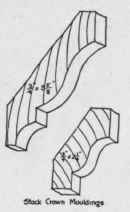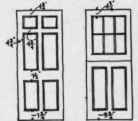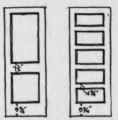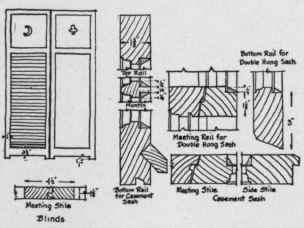Construction Of The Trim. Continued
Description
This section is from the book "The Construction Of The Small House", by H. Vandervoort Walsh. Also available from Amazon: The construction of the small house.
Construction Of The Trim. Continued
Softwood doors, 1 3/4 inches thick, have panels, if they are raised, only 1 1/8 inches thick; while doors 1 3/8 inches thick have raised panels only 9/16 inch thick, and flat panels 5/16 inch thick. The latter is quite evidently too thin for exterior doors.

Stock Bed Mouldings.

Interior doors of veneered woods usually have flat panels, 5/16 inch thick, except the one-panel door, which is as thick as 7/16 inch. Such panels consist of three layers, the two outside veneers and the interior softwood core with the grain running at right angles to the veneer. The stiles and rails of well-built veneered doors are made of built-up pine blocks, glued and locked together, with a tongueand-groove joint, and fastened at the corners with hardwood dowels. Strips of hardwood to match the veneered face should be placed on each edge of the stiles and rails.
The common-stock sizes of doors are as follows:

Stock Exterior Doors.

Stock Interior Doors.
2 feet by 6 feet.
2 feet by 6 feet 6 inches.
2 feet by 6 feet 8 inches.
2 feet 4 inches by 6 feet 6 inches.
2 feet 4 inches by 6 feet 8 inches.
2 feet 6 inches by 6 feet 6 inches.
2 feet 6 inches by 6 feet 8 inches.
2 feet 6 inches by 7 feet.
3 feet by 6 feet 8 inches.
2 feet 8 inches by 7 feet.
3 feet by 6 feet 8 inches. 3 feet by 7 feet.
The commonest type of window for the small house is equipped with the double-hung sash. This sash should be made of 1 3/8-inch white pine, mortised and tenoned at the corners. The meeting rail ought to be rabbeted so that water is prevented from seeping through, and the bottom rail ought also to be rabbeted to fit over a similar rabbet in the sill. The size of the lower rail is usually 3 inches wide, the sides and top rails 2 inches wide, and the meeting rail 1 3/8 inches wide. It is generally admitted that a window has little architectural charm without muntins, and these are made 3/4 inch wide, as a rule. The glass of the window is inserted into the sash frame at least 1/4 inch, and its plane is about one-third in from the outside face of the rails. The over-all dimensions of a window sash are determined by the size glass used, and as glass is cut in inches, the over-all dimensions of a sash will be in fraction of inches. For example, a double-hung sash of twelve lights, each 8 inches by 10 inches, will give a sash opening of 2 feet 4 1/2 inches by 3 feet. If the lights measure 9 inches by 12 inches, then the sash size will be 2 feet 7 1/2 inches by 4 feet 6 inches.
The best type of double-hung window-frame is constructed so that the blind stop is rabbeted to receive the pulley stile, preventing any wind from blowing through. The pulley stiles are usually made of yellow pine, but the outside casing and sills should be of white pine. It is also a good precaution to have the sill rabbeted to receive the ground strip, so that air cannot come underneath the sill. The use of 1 3/16 inch-thick material is common for all parts of the frame except the sill, which ought to be 1 3/4 inches thick. A 2 1/4-inch depth should be allowed for the weights in the box, and a space of 7/8 inch left between the stud and the top of the frame. Parting strips are made 3/8 inch wide.

Where the frame is to be built into a masonry wall, the back of the weight-box is closed in, and a moulding, called the brick mould, should be provided for covering the outside joint between frame and masonry. In order to make this joint tight in hollow-tile construction, it is essential to stuff the back of the brick mould with elastic roofing cement.
There is not much reason to rehearse here the pros and cons of the casement window. When such windows open in, the screens and blinds are easier to handle, but the weather is apt to leak in more. When the sash opens out, screening is difficult, unless some patent operating hardware is used, but the window is more weatherproof. In either case, the difficulty of weathering can be overcome to a large extent by not attempting to keep out the rain, but lead it down and around the sides, draining it off at the sill. This is accomplished by cutting a 1/4-inch half-round groove around the sides and in the sill to act as a canal for collecting the water which has seeped in. A few 1/4-inch round weep-holes from the groove in this sill outward will drain this collection of water off. Casement frames are made of heavier material than those used for double-hung sash, 1 3/4 inches being common. As the sash is hung from the sides like a door, its weight must not be so great that it will cause it to sag, and for this reason it is customary to limit the width of sash to 2 feet maximum. Some designers believe that the sash should also be at least 1 3/4 inches thick.

CASEMENT WINDOWS.
Although blinds add to the cost of the small house without apparently adding practical value, yet they are one of the most useful mediums of securing variation of color on the elevations. In Colonial days shutters served to protect the house, and were made solid with only a small hole in them, generally of some ornate cut-out design, like a half-moon, flower-pot, etc. To-day we want slats for ventilation. A good compromise, then, is to make the lower part of slats and the upper part solid, with a cut-out design. The stiles and rails of the shutter are made of 1 1/8-inch material, the bottom rail being 3 1/2 inches wide, the stiles and top rails 2 inches wide. Intermediate rails are often made 2 1/2 inches wide. It is best to project the stile 1 inch below the bottom of the lower rail, so that water collecting on the sill can drain off underneath the blind.

In addition to the blinds, the window should be equipped with screens. These should be of copper, for only this material is economical in the long run. They are usually made of 3/4-inch material, and the lower rail, stiles, and top rail made 1 3/4 inches wide.
Other mill work of the exterior, such as porch columns, rails, etc., ought to be built up from stock mouldings and patterns. There are numerous concerns selling well-designed wooden columns. The great danger of using stock columns, however, is in the fitting. Certain stock lengths are made with well-planned entasis, but if the design calls for an intermediate length the column is cut short, which destroys its proportions. On this basis many select square columns, or thin wooden columns without much entasis. The illustrations show some common-stock sizes for other outside trim, such as lattice, top rails, bottom rails, balusters, etc.
Of the interior mill work the stairs are the most important. For the small house they should be very simple, not only for economy but for appearance. Plain round and square balusters, 1 3/16 inch, and two to a tread, simple hand-rail and simple newel post, 3 3/4 inches, are more effective than elaborately turned members. The height of the hand-rail from the top of the tread to the hand-rail on a line with the face of the riser should be 2 feet 6 inches. The slope of the stairs should preferably be confined between 30 degrees and 35 degrees, and the common proportion between tread and riser should be maintained (tread and riser = 17 1/2 inches).


The treads should be of 1 1/8-inch hardwood, and the risers of 1 3/16-inch softwood, rabbeted into the riser. Outside strings ought to be 5/8 inch thick where finishing on a 5/8-inch base. Inside strings should be 1 3/16 inches thick. Enclosed stairs between walls should have strings fitted down on treads and risers, but elsewhere inside strings should be rabbeted for treads and risers. Newels should be housed out over supports.
A feature of the small house which is neglected too much is the installation of built-in furniture. There is a substantial quality about such furniture which no mobile furniture can possess. The bookcase built into the wall, the window-seat permanently a part of the room, a charming mantel-piece, good panelling, built-in china-closets, tables, and benches in the breakfast alcove, a modern kitchen dresser with the equipment of a portable cabinet, dressing-tables, and closet shelves and drawers,

This Is What The Speculative Builder
Spends money on medicine-cases and radiator enclosures are features which add so much to the small house that it seems strange that they are so often omitted. Many a speculative builder has realized the value of such furniture and sold his house upon the attractiveness of it. He knows that the young couple who purchases the small house usually comes from the small apartment, and has little furniture to spare. Here then is a place to spend money and not to economize.
Continue to:


